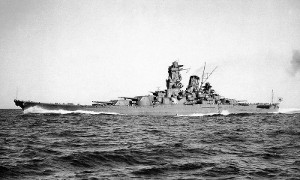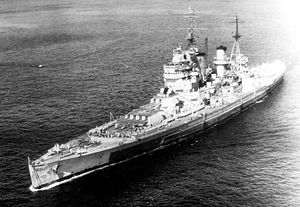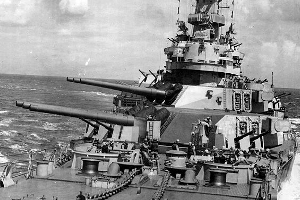Battleship Shootout: KM Bismarck vs. USS Iowa vs. IJN Yamato vs. HMS King George V
September 28, 2012 in General Topics
The battleship, moreso than any kind of warship–excepting perhaps the man O’ war–was often the visual representation of a country’s military might. Vast in expense, and finally rendered (mostly) irrelevant by air power, the last battleships in service were decommissioned in the early 90’s. Today, our own Marine Corps has lamented the loss of the battleship, which always made a terrific fire-support platform for assisting amphibious landings — you know, that function Marines make a fine art.
So having such admiration for these steel dragons, I’m going to give you four of the very best battleships of WWII, each of which embodied their country’s design strategy, and we’re going to unleash them against each other. And before anyone complains, I excluded ships that were commissioned after the war. So, no HMS Vanguard. Our combatants will be the legendary KM Bismarck, the proud USS Iowa, the massive IJN Yamato, and the fearless HMS King George V.
Load main batteries.
The Battlefield
For the purposes of our fight, I’ve selected an imaginary patch of sea in the Indian Ocean. Here we’ll have two small islands, each 300 feet at the highest, each 5X5 miles in size, and each twenty miles apart, arranged roughly on the centerline of a plot of water 40 x 40 miles in size. This ensures the ships can maneuver somewhat, but the terrain won’t be a deciding factor.
Each ship will be at the top of its WWII-era form. That also means any changes after that period will not be present. Sorry, Iowa–no tomahawk cruise missiles. Each ship will have a full crew, capable captains, and plenty of ammunition. This will be a free-for-all fight, and it ain’t over until only one ship is left above the waves.
So with that said, here’s how I see things shaking out, and why.
Have I lost my mind? Absolutely not. As cool as the Yamato was as a concept–a super-battleship, flinging 18.1″ shells at multiple targets simultaneously–I think she’s flawed.
Yes, she’s tough. She has 26″ armor plate on the front of her turrets. She took hundreds of bombs, and several torpedoes, before she went to the bottom in Operation Ten-Go. But this is a battle defined by two factors, in my opinion: accurate gunnery, and good damage control.
The Yamato had neither. The Japanese tendency towards counter-flooding probably stemmed from necessity, given all their top-heavy ships, but I think it was one of many questionable practices the Imperial Japanese Navy encouraged. I’ve also read more than a few sources suggesting the ship’s guns had accuracy issues, and that the Japanese were aware of this and tended to utilize she and her sister ship, Musashi, as deterrents and not active combatants. Since both ships have little true combat history, we’ll have to leave this to speculation, but I still don’t doubt it.
She’s also technologically behind her game. For all her firepower, she lacked true fire control radar (she had general-purpose radar sets, but nothing designed to aim her guns). This in itself wasn’t unusual for capital ships at this time, but it still puts her a little behind the other vessels present, who have better fire control systems.
She’s also using voice pipes–voice pipes. When shells start hitting her, confusion is going to multiply quickly.
Being the most prominent target on the battlefield, she is going to draw fire right out the gate. I see an unholy alliance between Iowa and Bismarck until Yamato goes to the bottom.
She’s a majestic vessel, an utter legend, but I think in this fight she’ll be a lame duck.
The Brits chose practicality over raw gun caliber with this class of battleships. Like her notable sister, Prince of Wales, King George V utilized lower-caliber 14″ guns, but did so in two turrets of four guns each, with an additional two-gun turret mounted just above and astern of the “A” turret. This meant she brought ten of these bad boys to the party. The philosophy behind this stated that 14″ shells could penetrate just about any naval armor, and the greater number of guns gave her a greater chance of landing hits. Law of averages, you know.
Plus, she has that always-impeccable British seamanship on her side. The Royal Navy doesn’t do anything halfway, including damage control. So, what’s not to love?
A lot, unfortunately. The 14″, quad-gun arrangement proved less-than-sterling in practice. It made for cramped gun turrets, as well as technical issues. King George V suffered gun malfunctions in training exercises and in combat–ironically, both she and Prince of Wales had main battery problems during showdowns with the Bismarck.
Those 14″ guns, being a smaller caliber, also have less effective range than those this ship’s adversaries are bringing to bear. Finally, she has the lowest overall tonnage, at just over 42,000 tons, and she’s a hair slower than the other vessels, so she’ll have a harder time getting her guns in range. This sets up a nasty scenario for her: she’ll have to advance, under the full weight of an enemy vessel’s broadside, having her “T capped” the whole time, until she’s finally in effective range.
Why does she make third? Ask the guys on Yamato.
The Bismarck is my all-time favorite warship, of any navy, in any time period, outside of perhaps the USS Enterprise, NCC-1701-E.
She’s a lovely lady, quite stunning, really–but don’t tell that to Captain Ernst Lindemann, who insisted on this ship being called a “He”.
I could spend all day telling you about this vessel, but let’s stick to the particulars relevant in this fight.
Bismarck has eight 15″ guns, arranged in four turrets of two guns each, meaning she loses less firepower, if a turret is knocked out, than her opponents do. She’s big, at a Washington Naval Treaty-busting 50,000 tons. She’s also fast, and her armor is proven effective–a debate rages to this day over whether the pounding she took in her final moments was really what took her out, or if her own crew scuttled her.
Bismarck‘s biggest problem, historically, was her mismanagement and misdeployment, as part of a surface fleet still hobbled by the fallout from the Treaty of Versailles, and with masters that didn’t quite know what to do with her. Here, she’ll do what she was designed to: engage at long range other capital ships, at a sort of stand-off distance.
This, provided she doesn’t completely unravel my order. See, historically, when facing down a hunter-killer fleet in her legendary final battle, Lindemann hoped targeting the oldest battleship present, HMS Rodney, might allow him to knock it out quickly, leaving him to deal with “just” King George V and a host of smaller-class vessels.
If he follows that reasoning here, he might maneuver to target ole’ George off the bat. That kind of scenario would completely upend my predictions.
Going with my assumed ranking, though, Bismarck loses this fight because while “he” does most things well–Iowa does everything great.
First Place: USS Iowa
And so, our queen of the seas is Iowa. I don’t expect everyone to agree with this–in fact, a few befuddled comments are always in store whenever you set up a match like this–but in my estimation, USS Iowa is simply the best ship in this battle. She’ll show up, put shells downrange, and get the job done.
Iowa was built to keep up with fast carriers. As such, the ship practically needs racing stripes. She’s the fastest present, at 32 knots, and pulls this off despite being similar in tonnage to Bismarck.
She’s a slugger, too: three turrets, each with three 16″ guns. They have good range, great killing power, and–this is key–Iowa has both top-notch fire-control radar and a CIC onboard (combat information center).
So she’s the fastest, most accurate vessel in this lineup. This gives her a battle-winning advantage in that she will literally be able to deploy her firepower when she sees fit, and withdraw it whenever necessary. In short, Iowa is going to loiter at the edges of the battlefield and *define* this fight.
Added to all of this is the tenacious American damage control ability.
In war, the victory results not so much as when one fights well, but rather when one forces their opponent to fight poorly. Iowa will do that, and win the day, though I imagine she’ll need some time in the drydock once her guns finally go silent.
I’d love to hear different opinions in the comments.
 An alien-enhanced super soldier and a reincarnated military genius spark a revolution in the shattered remnants of the United States.
An alien-enhanced super soldier and a reincarnated military genius spark a revolution in the shattered remnants of the United States.
Buy REVENANT MAN, Book One of The Tyrant Strategy, today.
(Acknowledgement: this post was inspired by author Geoff Micks and his commentary on an imaginary knife fight between all United States Presidents.)





Recent Discussion